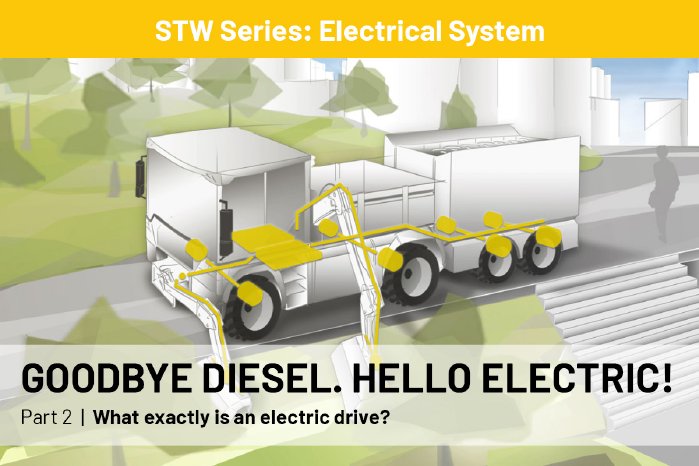With 35 years of experience in the digitalization, automation and electrification of mobile machines, we support our customers with customized workshops, the right concepts and suitable system architectures. But what exactly is this electrification? And how can I integrate it into my business model?
The energy flow in a vehicle with an internal combustion engine is well known. Through combustion, the chemical energy stored in diesel or petrol is converted into mechanical work and then mechanically transferred to the wheels. The energy stored in the fuel is enormous: One liter of diesel has an energy content of 10.4 kWh. However, most of the energy is released as heat into the surrounding area. Diesel engines for cars only achieve 40 % efficiency at their best operating point.
In an electric vehicle, the electric motor acts as an energy converter and generates the mechanical work required for the drive from electrical energy.
However, the synchronous and asynchronous machines used in automotive engineering do not operate with the DC voltage provided by the traction battery or fuel cell, but require AC voltage. That’s why a frequency converter, which carries out the necessary transformation, is installed in front of the electric motor. A combination of electric motor and frequency converter can achieve efficiencies of over 95 %.
In contrast to the internal combustion engine, the electric machine can easily turn in the opposite direction and thus allow a vehicle to reverse without a gearbox. Speed and torque can also be counter-directed. In this case the electric machine acts as a wear-free operating brake, converting the mechanical energy back into electrical energy. This energy can be fed back to the traction battery of the system. This process is also called recuperation.
This results in four operating states (four-quadrant operation) with an electric motor:
- Driving with acceleration
- Driving with retardation
- Reversing with acceleration
- Reversing with retardation
The components electric motor and frequency converter must be carefully aligned and together they form the electric drive. It is easier for users when both components can be purchased in a combined product.
In cooperation with the company Baumüller, STW has developed an electric drive specifically for use in mobile machines and in harsh environments. The powerMELA.x are characterized by their high power density, field-proven robustness and operation as generator, motor and brake with recuperation function.
The product already includes the inverter adapted to the electric engine. To save space, it is directly connected to the motor in the same housing. This eliminates complex cabling between the electric motor and the frequency converter as well as the associated EMC problems.
When operating with the DC link voltage of 650 V, current intensities and ohmic losses remain low even at high power levels. The powerMELA.x are available in the continuous power classes 80 kW and 140 kW. In addition, they can be combined as required thanks to their special synchronization.
Drives and generators




